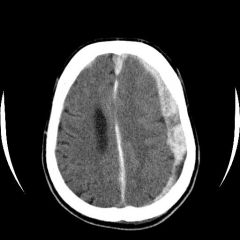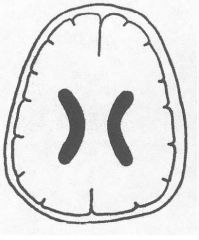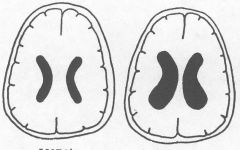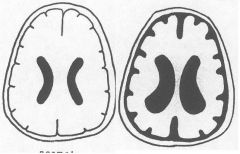![]()
![]()
![]()
Use LEFT and RIGHT arrow keys to navigate between flashcards;
Use UP and DOWN arrow keys to flip the card;
H to show hint;
A reads text to speech;
90 Cards in this Set
- Front
- Back
|
What is the innermost layer of the connective tissue membranes around the CNS?
|
The pia mater which closely adheres to the brain and spinal cord into every sulci and depression on the surface of the CNS.
|
|
|
What connective tissue membrane around the brain is vascular and carries the blood vessels that supply the CNS?
|
The pia mater
|
|
|
B/e what connective tissue membranes are the cisterna magna and lumbar cistern located b/e?
|
In the subarachnoid space which lies in b/e the pia mater and the arachnoid.
|
|
|
Where is the cisterna magna located?
|
Posterior to the medulla below the cerebellum
|
|
|
Where is the lumbar cistern located?
|
Below L1-2 where the spinal chord terminates.
|
|
|
What are the arachnoid trabeculae?
|
Thin threads of connective tissue that extend through the subarachnoid space connecting the arachnoid w/ the pia mater.
|
|
|
What space contains the CSF?
|
The subarachnoid space
|
|
|
Where do ruptured vessels in the pia mater bleed into?
|
The subarachnoid space.
*called a subarachnoid hemorrhage. |
|
|
What causes inflammatory cells to be found in the subarachnoid space?
|
Meningitis (an infection of the meninges)
|
|
|
B/e what vertebral levels do you insert the needle during a lumbar puncture?
|
L4-5
|
|
|
What is the outermost membrane surrounding the brain? what does it contain?
|
The dura mater which contains dense connective tissue and is very strong.
|
|
|
What layers does the dura mater contain?
|
An outer periosteal layer and an inner meningeal layer.
|
|
|
What does the periosteal layer of the dura mater contain? what does it attach to?
|
Contains blood vessels and nerves and is attached to the inner surface of the cranium.
|
|
|
What is the subdural space?
|
The potential space b/e the arachnoid and the dura.
|
|
|
What causes blood to collect in the subdural space or a subdural hematoma?
|
Venous in origin from head trauma that caused shearing of the bridging veins.
|
|
|
What is the epidural space?
|
The space b/e the dura mater and bone
|
|
|
What causes a epidural hemorrhage?
|
Arterial in origin from a laceration of the middle meningeal artery. These are more likely to be associated w/ a skull fracture.
|
|
|
What is the function of the dura mater?
|
Covers the entire brain and spinal cord all the way down to the second sacral vertebrae and helps anchor the spinal chord to the meninges
|
|
|
What do the denticulate ligaments do?
|
Anchor the spinal chord to the meninges.
|
|

What's the dx?
|
Subdural hematoma; notice the characteristic crescent shape b/c it is a venous hemorrhage.
|
|
|
Where is the falx cerebri? what does it do?
|
Extends into the interhemispheric fissure and divides the left and right halves of the brain.
|
|
|
What does the falx cerebri divide into?
|
The cerebellar tentorium
|
|
|
What is the cerebellar tentorium?
|
The two divisions of the falx cerebri that extends over the surface of the cerebellum
|
|
|
Where in the dura is the opening for the spinal chord located?
|
In the anterior edge of the cerebellar tentorium
|
|
|
What effect on the brain would increased intracranial pressure from a tumor or hemorrhage w/in the brain have?
|
Cause the temporal lobe to herniate through the opening of the cerebellar tentorium. the most medial portion of the temporal lobe (the uncus) will compress the ipsilateral oculomotor nerve (CNIII) resulting in 3rd nerve palsy.
|
|
|
What are the presenting symptoms of 3rd nerve palsy?
|
A dilated pupil w/ the eye deviated laterally. This is an ominous finding in comatose patients.
|
|
|
Where are the lateral ventricles located? what processes does it contain?
|
in the cerebral hemispheres w/ an anterior (frontal) horn, a posterior (occipital) horn, and an inferior (temporal) horn.
|
|
|
What borders the frontal horn of the lateral ventricle medially?
|
The septum pellucidum.
|
|
|
What bulges into the lateral aspect of the frontal horn?
|
The caudate nucleus.
|
|
|
What forms the medial wall of the inferior horn of the lateral ventricle?
|
The hippocampus.
|
|
|
What is the foramen of Monro?
|
CSF from each lateral ventricle communicates w/ the third ventricle through this foramen
|
|
|
What surrounds the third ventricle?
|
The two thalami
|
|
|
How does CSF from the third ventricle reach the fourth ventricle?
|
Via the cerebral aqueduct
|
|
|
What does the cerebral aqueduct divide?
|
The tegmentum from the tectum in the midbrain
|
|
|
Where is the 4th ventricle located?
|
B/e the pons and medulla (anteriorly) and the cerebellum posteriorly
|
|
|
How does CSF exit the 4th ventricle?
|
Via the two lateral foramens of Luschka and via the single middle foramen of Magendie.
|
|
|
What is the cisterna magna?
|
The outlet of the two foramen of Luschka and the foramen of Magendie.
|
|
|
Once leaving the brain through the cisterna magna where does CSF go?
|
Travels around the spinal chord to eventually come back around and empty into the superior sagittal sinus (the venous sinus over the interhemispheric fissure)
|
|
|
What are arachnoid villi?
|
Small evaginations in the wall of the arachnoid that protrude through the meningeal layer of the dura into the SSS that allow CSF to travel into the SSS.
|
|
|
What are arachnoid granulations?
|
Several arachnoid villi together
|
|
|
Why is CSF able to pass through the arachnoid villi?
|
B/c the hydrostatic pressure is higher in the subarachnoid space than in the venous sinus.
|
|
|
What does the SSS eventually drain into? where do both the venous blood and CSF exit the intracranial cavity?
|
Through the internal jugular vein
|
|
|
What is the continuation of the ventricular system in the spinal chord?
|
The central canal of the spinal chord.
|
|
|
What produces CSF?
|
The choroid plexus
|
|
|
Where is the choroid plexus located?
|
In the lateral ventricles, third ventricle and fourth ventricles.
|
|
|
What is the composition of CSF?
|
It is similar to blood except it has no RBCs or WBCs, the glucose is 2/3 that in blood and the CSF protein is ~0.5% that of blood.
|
|
|
What is the importance of the fact that the weight of the nervous tissue is only slightly greater than water?
|
1. It means the brain and spinal chord almost float in the CSF, this buoyancy reduces the weight of the nervous tissue and results in less traction on vessels and nerves.
2. It also minimizes the impact of external forces on the brain and spinal chord by serving as a cushion. 3. It also filters out potentially toxic substances from the brain. SO it reduces friction, reduces impact forces and filters the brains environment. |
|
|
What is the path of CSF circulation?
|
Lateral ventricles x2 => interventricular foramen of Monro x2 => Third ventricle => cerebral aqueduct => fourth ventricle => Foramen of Luschka x2 and foramen of Magendie => Cisterna Magna/Subarachnoid space => arachnoid villi => superior Sagittal Sinus => Cerebral Venous System => Internal Jugular vein
|
|
|
What is the total volume of CSF in the ventricular system and the subarachnoid space?
|
~150 mL in adults.
|
|
|
How much CSF is produced by the choroid plexus per day?
|
~500 mL, so the total amount of CSF is therefore renewed several times every day.
|
|
|
If there is a blockage of the cerebral aqueduct what will happen to the brain?
|
The third ventricle and lateral ventricles will dilate since the CSF produced in these ventricles cannot drain, but the fourth ventricle will not change in size.
|
|
|
What is the end-result of increased intracranial pressure in adults if it is not repaired? infants/children?
|
In adults it will result in herniation of the brain through the foramen magnum.
In infants/children (if the sutures have not closed) it will result in increased head circumference. |
|
|
What are the types of hydrocephalus?
|
1. non-communicating hydrocephalus
2. communicating hydrocephalus 3. hydrocephalus ex-vacuo |
|
|
What is a non-communicating hydrocephalus?
|
The CSF of some part of the ventricular system does not "communicate" w/ the subarachnoid space CSF.
|
|
|
What disorders produce a non-communicating hydrocephalus?
|
Anything that compresses the interventricular foramen of Monro, cerebral aqueduct or the outlets from the fourth ventricle.
|
|
|
In what kind of hydrocephalus should a lumbar puncture NOT be performed? why?
|
A non-communicating hydrocephalus b/c it lowers the pressure in the lumbar cistern and creates a greater pressure gradient b/e the ventricular CSF and subarachnoid CSF this can result in brain herniation.
|
|
|
What is communicating hydrocephalus?
|
The CSF of the ventricular system and subarachnoid space "communicate", but there is a blockage in the arachnoid granulations.
|
|
|
What diseases can cause a communicating hydrocephalus?
|
An old sub-arachnoid hemorrhage or meningitis which results in scarring and closure of the arachnoid villi.
|
|
|
What is hydrocephalus ex-vacuo?
|
As the brain atrophies (especially in neurodegenerative conditions like Alzheimer's) the ventricles appear larger. This is not the case! It is an optical illusion due to a loss of the normal brain tissue around the ventricles.
This is not a true hydrocephalus and is diagnosed by the presence of "hydrocephalus" on MRI or CT associated w/ a significant amount of atrophy present in the rest of the brain. |
|

What's the dx?
|
Normal
|
|

What's the dx?
|
Hydrocephalus
|
|

What's the dx?
|
Hydrocephalus ex vacuo
|
|
|
What is the blood-brain barrier?
|

The BBB separates the brain from the blood.
|
|
|
What are the three main components of the BBB?
|
1. endothelial cells
2. basement membrane 3. astrocyte foot processes. |
|
|
What is the most important component of the BBB?
|
The tight junctions b/e the endothelial cells b/c it forms the wall of brain capillaries.
|
|
|
What are circumventricular organs? what do they do?
|
Areas of specialized tissue located in the midline ventricular system that lack a BBB.
At the circumventricular organs, hormones and large peptides can be exchanged b/e the blood-brain-CSF. |
|
|
What is the area postrema?
|
A circumventricular organ that is sometimes called the "vomiting center" b/c it detects toxins such as the chemotherapeutic medication cisplatin.
|
|
|
Where is the area postrema?
|
Along the caudal wall of the 4th ventricle in the medulla.
|
|
|
What are the circumventricular organs?
|
1. Area postrema
2. Pineal gland 3. Subcomissural organ 4. Subfornical gland 5. Organum vasculosum of the lamina terminalis 6. Median eminence 7. neurohypophysis |
|
|
What is meningitis?
|
An infectious process involving the meninges and CSF.
|
|
|
What do pts w/ meningitis present with?
|
Severe headache and fever which typically progresses over hours, patients generally have pain w/ neck flexion which stretches the meninges.
Occasionally there will be a petechial skin rash in meningococcal infections. |
|
|
What should you do if you have a pt w/ meningitis?
|
make a RAPID dx!!! b/c there are many forms of meningitis which are treatable.
|
|
|
What are the differences in prognosis b/e bacteria, viral and fungal meningitis?
|
*bacterial meningitis is rapidly fatal.
*viral meningitis is generally benign and pts have a good recovery. *fungal meningitis results in chronic meningitis which presents more slowly and requires long-term treatment. |
|
|
What is the most likely cause of meningitis in pts who are 0-2 months old?
|
1. Gram-negative bacilli (ESPECIALLY E. Coli)
2. group B streptococcus 3. Listeria |
|
|
What is the most likely cause of bacterial meningitis in a patient who is 3 months- years old?
|
1. H. influenza (not as big a prob. anymore)
2. N. meningitides 3. S. pneumonia |
|
|
What is the most likely cause of meningitis in a patient who is 3 years old - adults?
|
1. S. pneumonia
2. N. meningitides |
|
|
What is encephalitis?
|
An invasion of the brain parenchyma itself by an organism that is almost always viral.
|
|
|
What do pts w/ encephalitis present with?
|
headache and fever like meningitis but also have symptoms suggestive of cortical involvement such as: seizures, lethargy -> coma, aphasia and sometimes focal weakness if motor cortex is involved.
|
|
|
What is the most important (specific) organism to consider in a pt presenting w/ encephalitis?
|
Herpes Simplex Encephalitis (HSE)
|
|
|
What age group does HSE typically affect?
|
Any age can be affected.
|
|
|
What are the most common Sys of HSE infection?
|
rapidly progressive headaches, fever, seizures, personality changes, encephalopathy and aphasia if language area is involved.
|
|
|
What is important in diagnosing HSE infection?
|
CSF analysis.
|
|
|
What would neuroimaging reveal in a pt w/ HSE infection?
|
Edema in the temporal lobe and most often in both temporal lobes.
Again, RAPID dxing is critical since untreated HSE results in death in at least 2/3rds of pts. |
|
|
What change in concentration of WBCs, RBCs, glucose, proteins would be seen in the CSF in bacterial meningitis? what other changes could be detected?
|
WBCs: LARGELY increased
RBCs: no change (zero) Glucose: drastically decreased Protein: drastically increased There would also be a positive culture. |
|
|
What change in concentration of WBCs, RBCs, glucose, proteins would be seen in the CSF in viral meningitis?
|
WBCs: inc.
RBCs: no change (zero) Glucose: normal Protein: inc. |
|
|
What change in concentration of WBCs, RBCs, glucose, proteins would be seen in the CSF in HSE? what other changes can be detected?
|
WBCs: inc.
RBC: inc. (more than zero) Glucose: normal or dec. protein: increased The CSF would also be PCR positive. (which is amplifying foreign DNA content to detect small things like viruses) |
|
|
What change in concentration of WBCs, RBCs, glucose, proteins would be seen in the CSF in subarachnoid hemorrhage? what other change would be detected?
|
WBCs: inc. proportional to RBCs
RBCs: DRASTICALLY inc. Glucose: dec. Protein: inc. There would also xanthochromia (or the CSF would be yellowish) |
|
|
What change in concentration of WBCs, RBCs, glucose, proteins would be seen in the CSF in fungal meningitis? what other things could be detected?
|
WBCs: inc.
RBCs: zero Glucose: drastically dec. Protein: inc. There would be a positive culture of fungus from the CSF. |
|
|
What is a "traumatic tap"? how can you tell whether a traumatic tap occurred?
|
During a lumbar puncture a missed stab of the needle results in and elevated RBC count but the number of RBCs decreases w/ each tube in a traumatic tap.
|
|
|
How can you distinguish b/e a subarachnoid hemorrhage and a traumatic tap?
|
The number of RBCs will dec. in a traumatic tap w/ each successive test tube.
Checking for xanthochromia, in sub-arachnoid hemorrhages the RBCs will lyse during centrifuging and turn the CSF yellow b/c of bilirubin. In a traumatic tap there is no xanthochromia. |

